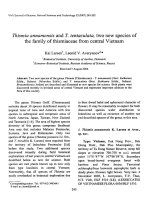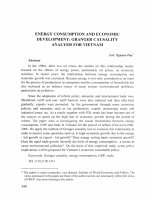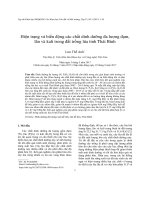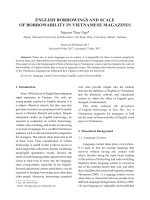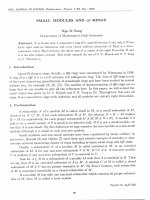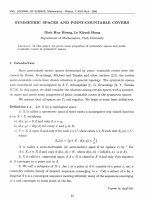DSpace at VNU: Symmetric spaces and point - countable covers
Bạn đang xem bản rút gọn của tài liệu. Xem và tải ngay bản đầy đủ của tài liệu tại đây (2.56 MB, 8 trang )
V N U . JO U R N A L O F SC IE N C E , M a th e m a tics - Physics. T .X X II, N 0 3 - 2006
S Y M M E T R I C S P A C E S A N D P O I N T -C O U N T A B L E C O V E R S
D in h H u y Hoang, Le K hanh H ung
D epartm ent o f M a th e m a tic s V in h University
A b s t r a c t . In t h is p a p e r , w e p r o v e s o m e p r o p e r tie s o f s y m m e tr ic s p a c e s a n d p o in t -
countable covers in symmetric spaces.
1. I n tr o d u c tio n
Since generalized m etric spaces determined by point- countable covers were dis
cussed by Burke, Gruenhage, Michael and Tanaka and other authors [2,3], the notion
point-countable covers have drawn attention in general topology. The sym m etric spaces
were introduced and investigated by A .v. Arhangelskii [1], G. Gruenhage [3], Y. Tanaka
[6,7,9]. In this paper, we shall consider the relations among certain spaces with a sym m et
ric space and prove some properties of point- countable covers in the symmetric spaces.
We assume th a t all spaces are T\ and regurlar. We begin at some basic definitions.
D e fin itio n 1 . 1 .
Let X be a topological space.
1) X is called a symmetric space if there exists a nonnegative real valued function
d on X X X satisfying
a) d ( x , y ) = 0 if a n d o n ly if X = y;
b) d( x, y) = d(y, x) for every X and y in X]
c) u c X is open if and only if for each X E Í/, there exists 71 E N such th a t s n (x ) c [/,
where
Sn(x) = {y e X : d(x, y) < - } .
n
X is called a semi-metrizable (or semi-metric) space if we replace c) by ” For
A c X , x £ A 'Ú and only if d( x , A) = 0” , where d( x, A) = inf {d(x, a) : a G A}.
2) X is called a sequential space, if A c X is closed in X if and only if no sequer.ce
in A converges to a point not in A.
3) We call a subspace of X a fan ( at a point X) if it consists of a point X, anc a
countably infinite fam ily of disjoint sequences converging to X. Call a subset of a far. a
diagonal if it is a convergent sequence meeting infinitely many of the sequences converging
to X and converges to some point in the fan.
Typeset by .AjVfS-TgX
23
D in h H u y H oan g, Le K hanh H ung
24
X is call Ơ4 -space if every fan at X of X has a diagonal converging to X.
D e fin itio n 1.2. Let X be a space, and V a cover of X . P u t
v 1) V is a k-network if, whenever K c Ư with K com pact and u open inX , th en
K CUT CƯ
for some T G V
Xe p c u
for some p E V .
3) p is a p-k-network if, whenever K c X \ {y} w ith i f com pact in X , then
c U7=* c X \ {y}
for some T E p
a point X G X w ith the property: For any neighborhood u of X, there exists p E ? such
th at p c u and p n A is infinite.
5) V is a cs* -network if {xn} is a sequence converging to X G X and u is a neigh
borhood of X, there exists F g P such th at
{x} u {xn . : i G N} c p c u
for some subsequence {xn .} of {xn }.
6) V is a wcs* -network if {xn} is a sequence converging to X G X and u is a
neighborhood of X, then there exists a P g P such th a t
{xni : i e N} c p c £/
for some subsequence {xn .} of {xn}.
7) V is a p-wcs*-network if { x n} is a sequence converging to X G X and X ^ Ị / , then
there exists P g P such th a t
{xni : z G N} c p c X \ {y}
for some subsequence { x n } of {xn}.
S y m m e t r i c sp a c e s a n d p o in t-c o u n ta b le covers
25
D e fin itio n 1.3. For a space X and X E p c X ì p is called a sequential neighborhood at
X in X if, whenever {xn } is a sequence converging to X in X , then x n e p for all but
finitely many n G N.
D e fin itio n 1.4.
Let V = \J {V X : X G X } be family of subsets of X which satisfies that
for e a c h X £ X ,
1) Vx is network of X in X ,
2) l ỉ ư , v
then w c u n V for some w
€ Vx.
V is an sn-network for X if each element of V x is a sequential neighborhood of X in
X.
V is a weafc base for X , if a subset G of X is open in X if and only if for each X e G
there exists p G V x such th a t p c G.
A space X is an snf-countable space if X has an sn-network V such th a t each Vx is
countable.
A space X is a gf-countable space if X has a weak base V such th a t V x is countable
for every X E X .
D e fin itio n 1.5. Let X be a space. A cover V iscalled point-countable if for every X E X ,
the set { p E V : x E p } is at m ost countable.
It is clear th a t [10]
weak base
sn-network
cs*-network
wcs*-network
<--------
k-network
p-wcs*-network <-------- p-k-network
In this paper we shall provide some partial answers for connections between kinds of
network in the sym m etric space.
D in h H u y H o a n g , Le K h a n h H u n g
26
2. The main results
T h e o r e m 2.1. Let X be a symmetric space. Then
1) X is a gf-countable space;
2) X is a sequential space;
3) X is an snf-countable space;
4) X is an a^-space.
Proof. 1) For each X E X put
v x = {s n (x ) : n = 1,2,...}
and V = {Vx : X £ X}. It is clear th at V is a weak base for X . Since V x is countable for
every X e X , X is a gf-countable space.
2) Let A be a subset of X . Assume th at, if any sequence {xn} in A converging to
X then X G A. We show th a t A is closed. If it is not the case, then, there exists X € X \ A
such th at 5„(x) n A Ỷ 0 for every n e N * . For each n G N* choose x n € s n (x) n A. Then,
the sequence {xn } is in A and converges to X. Since X ị A, we have a contradition.
Conversly, suppose th a t A is closed. It
follows easily th a t, if {xn } c
A is sequence
converging to X, then X G A. Thus X is a sequential space.
3) It is sufficient to show th a t V is an sn-network. Suppose the assertion is false.
Then, there exists Po € Vx and a sequence {xn} c X \ Po w ith x n —> X. It follows th at
the subset {:rn : n e N} is not closed and hence X \ { x n : n € N} is not open. Let
y e x \ { x n : n € N}.
If y = X then
y e Po c X \ {xn : n € N}, Po € Vy.
Assume th at y ^ X.
Then y e X \ ({xn : n G N} u {x}). Since {xn : n
€ N} u {x}is
closed, there exists p &Vy such th a t
y e p c X \ ( { x n : n € N} u { x } ) C l \ { x „ : n E N } .
Hence X \ { x n : n e N} is open. This is a contradiction.
4) Assume th a t M is a fan at X in X with
M = i^ } u {x nm ■m e N},
n£N
where {xnm : m e N}„6n is a countable family of disjoint sequences converging to X.
S y m m e t r i c spaces a n d p o in t-co u n ta b le covers
27
Since V is an sn-network, S n (x) is sequential neighborhodd of X for every n = 1,2,....
It follows th a t for each k e N and for each Sn (x) there exists m nk € N such th at
Xkm € 5 n (x)
for
771 > m nk.
This yields
{xkm : m G N} n S n(x) Ỷ 0
for all
k
and
n € N.
Choose
Vn € {^nm ■TI ẽ N} n S n ( x )
and put c — {yn : n e N}. Then
c n {xnm : m 6 N} = {yn}
for all
n G N.
Let u be a neighborhood of X. T hen there exists no e N such th a t S no( x ) c u .Hence
yn € s n (x) c Sn0(x) c u
This means th at
for all n ^ no-
yn—>X and hence c is a diagonal of M converging to X. Thus X is an
» 4 —space.
P r o p o s itio n 2 .2 . Let X be a symmetric space. Then the following are equivalent :
1) X is a semi-metric space;
2) For every X e X
and
r > 0, the subset
Sr( x) = { y e Y : d ( x , y ) < r}
is a neighborhood o f X.
Proof. Assume th a t
X is a semi-metric space, X e X and r > 0. Then,
A = { y ( = X : d(y, A) = 0} for all i c l .
E — x \ Sr(x).
Since d ( x , E ) ^ r > 0, x Ệ E. It follows th at, there exists a open subset u in X such th at
x e u CX\E.
If 2 € u , then z ị E. T his m eans z € Sr (x) and hence u c S r (x). Thus S r(x) is a
neighborhood of X.
D in h H u y H o a n g , Le K h a n h H u n g
28
Conversly, assume th a t S r (x) is a neighborhood of X for every X G X and r > 0.
Let Ẩ b e a subset of X and X G A. Then S r ( x ) n A Ỷ 0
f°r all r > 0- Hence d ( x , A ) = 0.
Let X e X with d ( x , A) = 0. Suppose X ị A. Then
X e U c X \ A
for some neighborhood u of X. It follows th at, there exists n G N such th at
Sn{ x ) c U c X \ A .
This yields
d(x,Ẩ ) 'ỷ d( x, A) ^ — > 0
7i
We have a contradiction. Hence X £ A and
A = { x e X :d{x,A) = 0}.
Thus X a semi-metric space.
For any space, the following hold:
k - n e tw o r k => w cs* -n etw o rk ,
p - k - n e tw o r k => p -w cs* -n e tw o rk .
The converses are false in generality case. However, we have following results for symmetric
spaces.
T h e o r e m 2.3. Let X be a symm etric space and V be a point-countable cover o f X. Then
1) V is a k-network i f and only i f it is a wcs*-network.
2) V is a p-k-network i f and only if it is a p-wcs*-network.
Proof. 1) T he ’’only if ’ part is clear, so we only need to prove the ” iP
part. Let A" be a
compact subset of X and u an open set in X such th a t K c u. For each x G l , since V
is point-countable, we have
{ P e r : x e P c U } = {Pn (x) : n E N}.
We will show th a t K is covered by some finite subset V' c {Pn (x) : X E (7, n G N}. If it is
not the case, let £o £ K- Then, there exists X\ G K \ Po(^o)- Since
K
PoOo) u P i(io ) u P q( xx ) u -Pi(xi),
there exists
x 2 e A '\ Ị j { P t (xj) : 0 ^ i, j < 2}
S y m m e t r i c sp a ces a n d p o in t-c o u n ta b le covers
29
Continued applying this argum ent, we obtain the sequence { x n } c K such th a t
x n G K \ u {Pi (xj ) : 0 ^ z, j < n}
for
71 = 0,1, 2..
(1)
By the Theorem 2.1, X is a sequential space. Since K is compact, there exists a subseqnence { x n } of { x n } such th a t x n. —> X G K . As V a wcs*-network, there exists a
subsequence {xn . } of {xn .} such th a t
{xni : /c G N} c p c Í/
for some p e V.
Then, there exist m and £n .. such th a t p = p m(xn ..). P u t no
=
m ax (m ,n i j ). By (1),
Xn ị Pm(xni ) = p
for all
n > n 0.
This is a contradiction. T hus V is a k-network.
2) The proof for 2) is similar, w ith u is replaced by X \ {y}.
P r o p o s itio n 2.4. [9] 1) I f V is an s-network in any space X , then V is a wcs*-network.
2) I f X is a sequential space and V is a wcs*-network, then V is an s-network.
Proof. 1) Let {xn } c X be a sequence converging to X. W ithout loss of generality we can
assume th a t x n Ỷ x for all n • P u t A = { x n : n = 1 ,2 ,3 ,...}. Since A is not closed and V is
an s-network, there exists y G X w ith the property: For any neighborhood u of y, there
exists P g P such th a t p c u and p n A is infinite. Hence there exists the subsequence
{xn i} of {xn } such th a t
{ x ni } c P c U
Thus we only need to show th a t y = X. Suppose Ị/ / I . Then, since A u {x} is closed,
there exists the neighborhood u of y such th a t u n (i4 u {x}) = 0. For each p € V , p c
u
we have p n A = 0. T his is a contracdiction.
2)
Let A be a not closed subset in X . Since X is a sequential space, there exists
the sequence {xn } c A such th a t Xn —>X ị A. For every neighborhood
u of X, since V
a wcs*-network, there exists p G V and the subsequence { x n } of { x n } such th a t
{ x ni : i e N} c p c u .
This means th a t p n A is infinite and hence V is an s-network.
is
D in h H u y H o a n g , Le K h a n h H u n g
30
Corollary 2.5. The following are equivalent for a sym m etric X :
1) X has a point-countable s-network
2) X has a point-countable wsc*-network
3) X has a point-countable cs*-network
4) X has a point-countable k-network
Proof. 1)
2) by Theorem 2.1 and Proposition 2.4.
2) «=> 4) by Theorem 2.3.
2) <=> 3) by Theorem 2.1 and Theorem 7 in [10].
References
1. A.V.Arhangel’skii^ M appings and spaces, Russian Math. Surveys,21(1966),115-162.
2. D. Burke and E. Michael, On certain point- countable covers, Pacific J. Math., 4
(1976), 79-92.
3. G. Gruenhage, Generalized metric spaces, in: K. Kunen an J. E. Vaughan, eds.,
Handbook of Set- theoretic Topology, North- Holland, (1984).
4. G. Gruenhage, E. Michael and Y. Tanaka, Spaces determ ined by point-countable
covers, Pacific Journal of Math., 113 (2) (1984) 303-332.
5. S. I. Nedev, On metriczable spaces, Transactions of the Moscow Math., Soc., 24(
1971), 213-247.
6. Y. Tanaka, On sym m etric spaces, Proc. Japan Acad., 49 (1973), 106- 111.
7. Y. Tanaka, Symmetrizable spaces, g-developable spaces and g-metrizable spaces,
Math. Japonica., 36 (1991), 71-84.
8. Y. Tanaka, Point-countable covers and k-networks, Topology-Proc., 12 (1987),327349.
9. Y. Tanaka, Theory of k-networks II,Q and A in General Topology.,19 (2001), 27-46.
10. P. Yan and s. Lin, Point-countable k-networks, cs*-network and a 4-spaces, Topology
Proc., 24(1999), 345-354.
